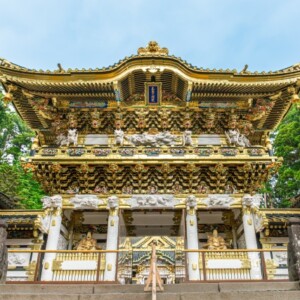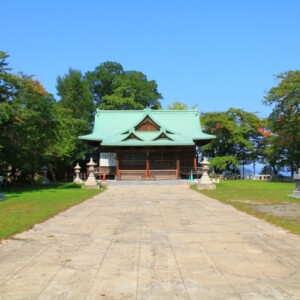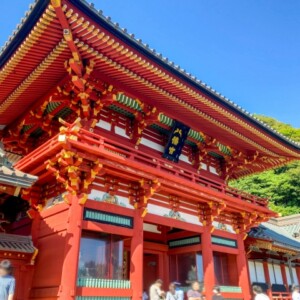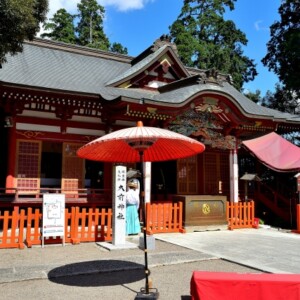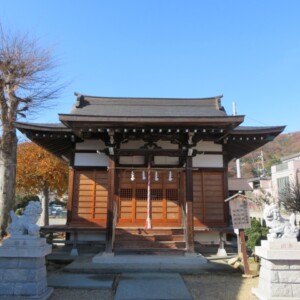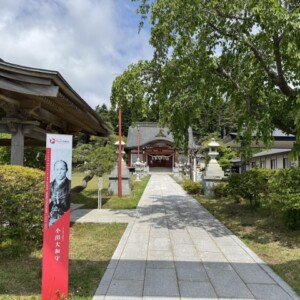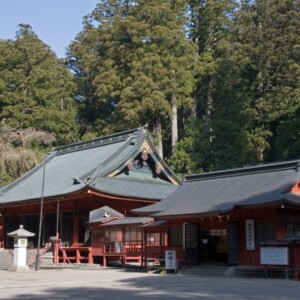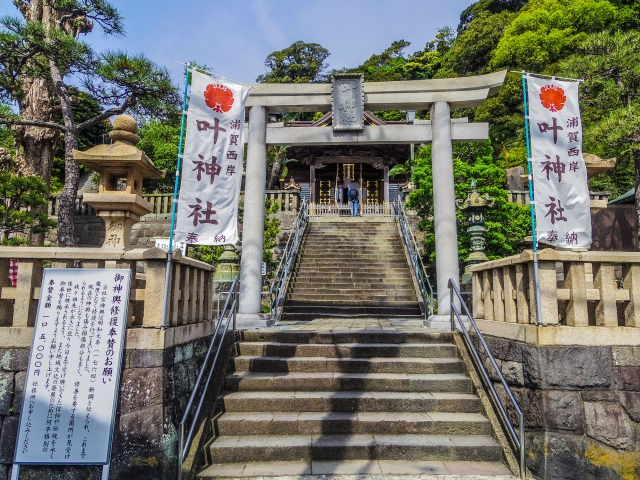
Kano Shrine|A complete guide to the history, highlights, and worship information of this historic shrine where the wish for the revival of the Genji clan was granted.
Kano Shrine, located in Uraga, Yokosuka City, Kanagawa Prefecture, is a historic shrine named after Minamoto no Yoritomo’s wish for the revival of the Minamoto clan, which was granted. It consists of two shrines located east and west across the port of Uraga, and is visited by many worshippers as a power spot for matchmaking.
Outline and basic information about Kano Shrine
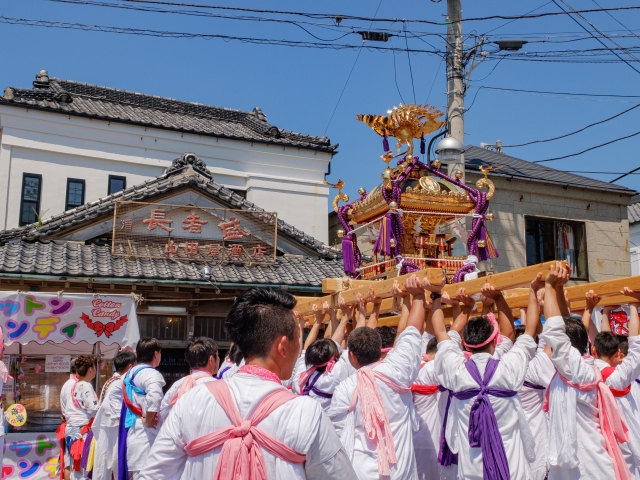
Kano Shrine is located in the Uraga district of Yokosuka City, Kanagawa Prefecture, and has the unusual form of two shrines, one on the east and the other on the west across Uraga Harbor. Although the official name of both shrines is “Kano Shrine,” the shrine in Nishi Uraga is generally referred to as “Nishi Kano Shrine” and the shrine in Higashi Uraga as “Higashi Kano Shrine.
Both shrines are venerable Hachiman shrines whose main deity is Eitabetsunushi (Emperor Ojin) and were recommended by Ishimizu Hachiman-gu Shrine. The shrine is especially known for its blessings for marriage, and in recent years it has become a popular power spot, especially among young women.
History and Origin
Kano Shrine was founded in the late Heian period (794-1192), on August 15, 1181. There is an interesting history behind the founding of the shrine.
It is said that the shrine was founded by Bunkaku Shonin, a priest of Jingo-ji Temple on Mt. Takao, who had become acquainted with Minamoto no Yoritomo, who was exiled to Izu during the Genpei wars. He trained himself at Mt. Shikano in Joso and built the shrine here to express his strong wish for the revival of the Minamoto clan.
Later, when Minamoto no Yoritomo overthrew the Taira clan and opened the Kamakura shogunate, thus reviving the Minamoto clan, his wish “came true” and the shrine came to be called “Kano-daimyojin” or “Kano Shrine. The very name of the shrine is a precious reminder of a major turning point in history.
In the Edo period (1603-1867), the magistrate’s office was moved from Shimoda to Uraga, and Kano Shrine was deeply revered for generations by the samurai who were appointed as magistrates. The shrine was so revered that the magistrate himself paid homage and offered offerings at the two major festivals held in spring and fall.
Gods and Benefits
The main deity of Nishikano Shrine is Hidabetsunushi (Emperor Ojin), and the deities enshrined at the shrine are Hime, Isochobihime (Empress Jingu), Amaterasu, Hoshoku, Daimonaki, Shomahiko-no-mikoto, Hijisanrei-no-mikoto, and Hakusan-hime.
The main deity of Togane Shrine is also Honoritabetsunushi (Emperor Ojin). Both shrines worship the same Hachiman deity as Ishimizu Hachiman-gu Shrine, and are said to bring blessings such as longevity of military fortune, luck in victory, and protection from bad luck.
Of particular note is the blessing of marriage. The word “kano” is believed to bring good luck, and the shrine is visited by worshippers from all over the country who wish for the fulfillment of their love, a good marriage, or the reconciliation of husband and wife.
It is also believed to grant the power to overcome difficulties and the courage to take on new challenges, because of the history of the fasting asceticism of Kaishu Katsu before his crossing of the Pacific Ocean in the “Kanrin Maru”.
Highlights and Features of Kano Shrine
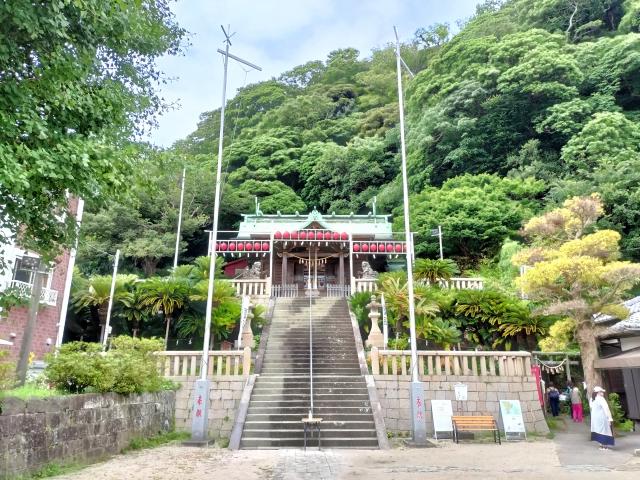
The most distinctive feature of Kano Shrine is that it sits on two separate sides of Uraga Harbor, one on the east and the other on the west. This unusual arrangement, the unique charm of each shrine, and the cultural assets of great historical value are highlights of the area.
Two shrines divided into east and west
Nishikano Shrine is located at 1-1-13 Nishiuraga, Yokosuka City, and has a long history, being founded in 1181. The stone steps are flanked by cycad trees that Minamoto no Yoritomo is said to have transplanted and dedicated from Izu, giving the shrine a sense of its historical significance.
The ceiling of the hall of worship is decorated with pictures of rare flowers and birds that are said to have not been introduced to Japan at that time. There is also a magnificent carving of Rikigami, the god of strength, who supports the muneki.
Higashikano Shrine is located at 2-21-25 Higashi-Uraga, Yokosuka, and was built in 1644, the first year of the Shoho Era (early Edo Period), with a request from Nishikano Shrine. Until the separation of Shinto and Buddhism in the Meiji era (1868-1912), the shrine had a history of being a separate temple of the Daigo school of the Shingon sect called Yohshinzan Eishinji Temple.
It is interesting to note the characteristics of the komainu (guardian dogs) of both shrines. The two sets of komainu at Nishikano Shrine look like “A-gata” (open-mouthed), while the two sets at Higashikano Shrine look like “Un-gata” (closed-mouthed), suggesting that they are a pair. The guardian dogs of the Higashikano Shrine are each holding a child, and the child of the guardian dog on the right can be seen drinking milk, which is unusual.
Historical Sites Related to Kaishu Katsu
Higashikano Shrine is home to valuable historical sites related to the great Kaishu Katsu of the late Edo period. There is an anecdote that before embarking on the arduous voyage across the Pacific Ocean on the “Kanrin Maru,” Kaishu Katsu purified himself and strengthened his spirit at this shrine.
Behind the shrine office, there is a well where Katsu Kaishu is said to have performed mizukin-ripa, and the well can still be seen today. It is said that after purifying himself with cold water from this well, he went to the top of Myojinzan (Mt. Myojin) in the back of the shrine to practice fasting.
Myojin is a small mountain about 53 meters high, and the inner shrine of Togane Shrine is enshrined at its summit. On the left side of the mountain, there is a marker that reads “Katsu Kaishu’s place of fasting,” allowing visitors to follow in the footsteps of the great man who opened the door to a new era during the turbulent years at the end of the Tokugawa Shogunate. From the top of the mountain, a panoramic view of Uraga Port and the Boso Peninsula can be seen, and Kaishu Katsu may have renewed his resolve as he gazed at this view.
It is also known as the site of Uraga Castle because of its military history: during the reign of the Go-Hojo clan, naval forces were stationed on this Myojinzan Mountain to prevent attacks on the Miura Peninsula by the Satomi navy on the Boso Peninsula.
Shrine forest designated as a natural monument by the prefecture
Myojin,” a mountain behind Higashikano Shrine, was designated as a Kanagawa Prefecture-designated natural monument on December 17, 1976 as “the shrine forest of Kano Shrine.
The beauty of this forest lies in its well-preserved natural forest. An evergreen broad-leaved forest extends to the 53-meter-high summit, with the summit area covered by a sudajii forest and the slopes by a tabunoki forest. Tabunoki trees (20 to 22 meters high) dominate the taller trees, while camellia, dogtooth violet, and motinoki trees grow in the sub-taller trees.
Of particular note is the native ubame oak (Quercus phillyraeoides). Myojinzan and Jōgashima are the only places in Kanagawa Prefecture where the ubamegashi grows naturally, and this is considered to be the northern limit of its distribution. This fact shows that the ecosystem of this area is very valuable from a scientific point of view.
In the shrub layer, tobera, aoki, shirodamo, yatsuden, yabunikkei, obagumi, murasakishikibu, etc. can be seen, and in the herbaceous layer on the forest floor, kizuta, yaburan, vinancazura, inode, benishi fern, teikazura, etc. are growing, creating a rich natural environment even in an urban area.
Guide to Worship and Visiting
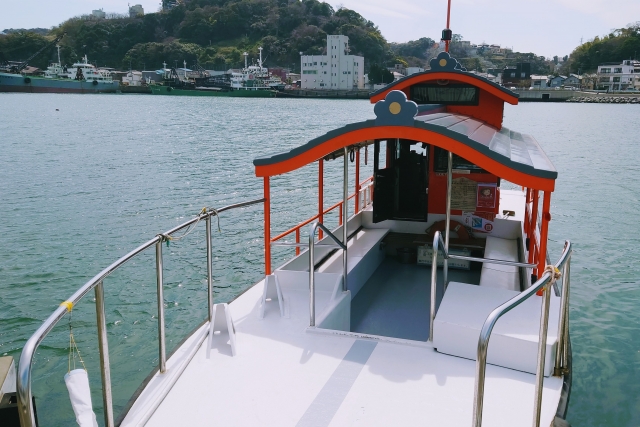
Visiting Kano Shrine follows the general manner of shrine worship, but there is a special way to enjoy visiting the two shrines in the East and West. Another major attraction is the method of awarding special amulets, which are famous for marriage.
Worship Etiquette and Manners
To pray at Kano Shrine, first bow in front of the torii gate before entering the shrine grounds. After purifying your hands and mouth at the hand- and mouth-watering basin, you will pray in front of the hall of worship in the manner of “ni-ai ni clap ni shite ippai.
There is no specific order for visiting the East and West shrines, but most visitors come to the Nishikano Shrine first, and then to the Higashikano Shrine. This is because this is related to the method of awarding marriage talismans.
To travel between the two shrines across Uraga Harbor, visitors can use a small ferry called “Uraga no Ferry. This ferry is also used as a means of transportation for local residents, allowing visitors to enjoy the atmosphere of olden times while visiting the shrines. However, it is recommended to check in advance as the ferry may be cancelled due to weather or operational conditions.
Special way to receive the marriage talisman
One of the most unique features of Kano Shrine is the special system of marriage talismans awarded at the two shrines (East and West), a new initiative realized at the turn of the 21st century through discussions between the priests of the two shrines, which has been well received by many visitors to the shrine.
First, visitors receive a “kodama amulet” at Nishikano Shrine. These amulets come in various types, including crystal, and visitors can choose one according to their preference. Next, you will receive an amulet bag at Togane Shrine, and place the amulet from Nishikane Shrine in the bag to make a complete marriage amulet.
Wearing this amulet is believed to bring about a variety of good marriages, including love, and attracts many people seeking a good marriage, including couples and married couples. Visitors can choose any combination of the amulet and amulet bag to create their own special amulet.
Information on red seals and amulets
Both shrines offer red seals, each with a different design. At Togane Shrine, a red seal book with a design of Kanrinmaru is also available, which is popular as a souvenir of the shrine’s connection with Kaishu Katsu.
It is also possible to have red seals from both Nishikano Shrine and Higashikano Shrine written on a facing page, which many visitors request as a commemorative gift for visiting the two shrines.
In addition to marriage charms, there are various other types of good luck charms available, such as those for warding off bad luck, traffic safety, and academic success. In particular, amulets with the character for “kano” are popular as they grant various wishes.
Annual events include the New Year’s Day Festival on January 1, the Setsubun Festival in February, the Prayer Festival in late March, and the Summer Exorcism Ceremony on June 30, and the Grand Festival is held in spring and fall.
Access/Use Information

Kano Shrine can be accessed by both public transportation and automobile. Since the shrines are located on the east and west sides of Uraga Harbor, the following is a brief description of how to access each of the shrines.
Access by Public Transportation
Access by train
The nearest station is Uraga Station on the Keikyu Line. Uraga Station is the last stop on the Keikyu Main Line.
Nishikano Shrine is about a 10-minute walk from Uraga Station. It can be accessed by exiting the station, heading in the direction of Uraga Port and walking along the harbor.
To get to Higashikano Shrine, it is convenient to take a bus from Uraga Station. Get off at the Shinmachi bus stop on the Keikyu Bus and walk about 7 minutes from there. Alternatively, it is also accessible from Uraga Station by foot in about 15 minutes.
Access by car
It takes about 5 minutes by car from the Uraga Interchange on the Yokohama-Yokosuka Road. It takes about 1 hour from the Tokyo area.
Traveling by ferry in Uraga
The Uraga Ferry, which comes and goes from Uraga Port, can be used to travel between shrines on the east and west sides of the island. The ferry is a short trip of about 3 minutes, but it is a valuable experience that allows visitors to experience the history of Uraga while traveling between shrines. Fares are 200 yen for adults and 100 yen for elementary school students, and the ferry operates from 7:00 am to 6:00 pm (5:00 pm in winter). However, the service may be cancelled in case of stormy weather.
Hours of Operation, Fees, and Parking Information
Hours of visitation
Both shrines can be visited freely, but the shrine office is open from 9:00 a.m. to 5:00 p.m.
Admission】 【Visiting Fees】.
There is no charge to visit the shrines. A separate fee is required to receive a red seal or amulet.
Parking】 【Parking Lot
Nishikano Shrine has its own parking lot. There are also parking spaces for several cars at Higashikano Shrine by the torii gate and on the seaside. However, since the number of cars is limited at both shrines, please consider using public transportation when visiting the shrine.
During the New Year’s holiday and major festivals when crowds are expected, we recommend using paid parking in the area or public transportation.
<Address.
Nishikano Shrine: 1-1-13 Nishiuraga, Yokosuka-shi, Kanagawa 239-0824
Higashikano Shrine: 2-21-25 Higashi-Uraga, Yokosuka-shi, Kanagawa 239-0821
Reference site
Kano Shrine official website: https://kanoujinjya.jp/
Yokosuka City Tourism Information: https://www.cocoyoko.net/spot/higashi-kanou-z.html



